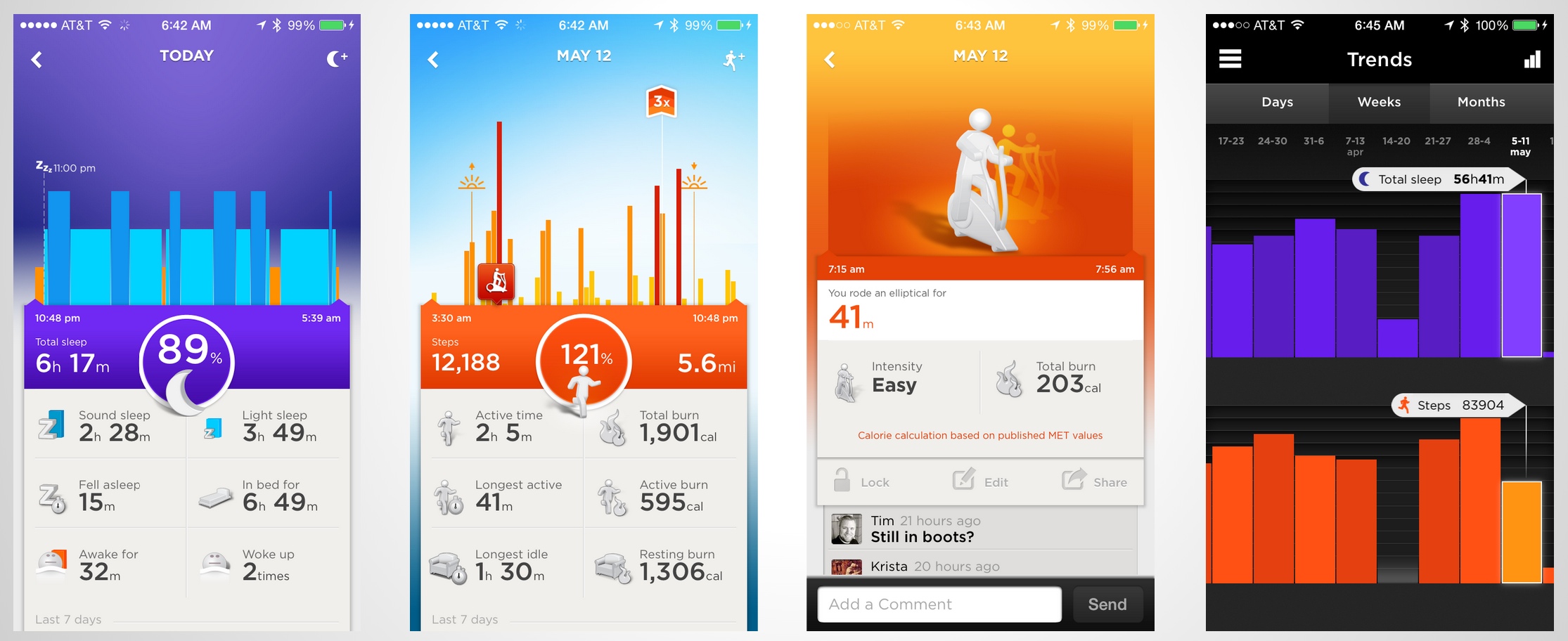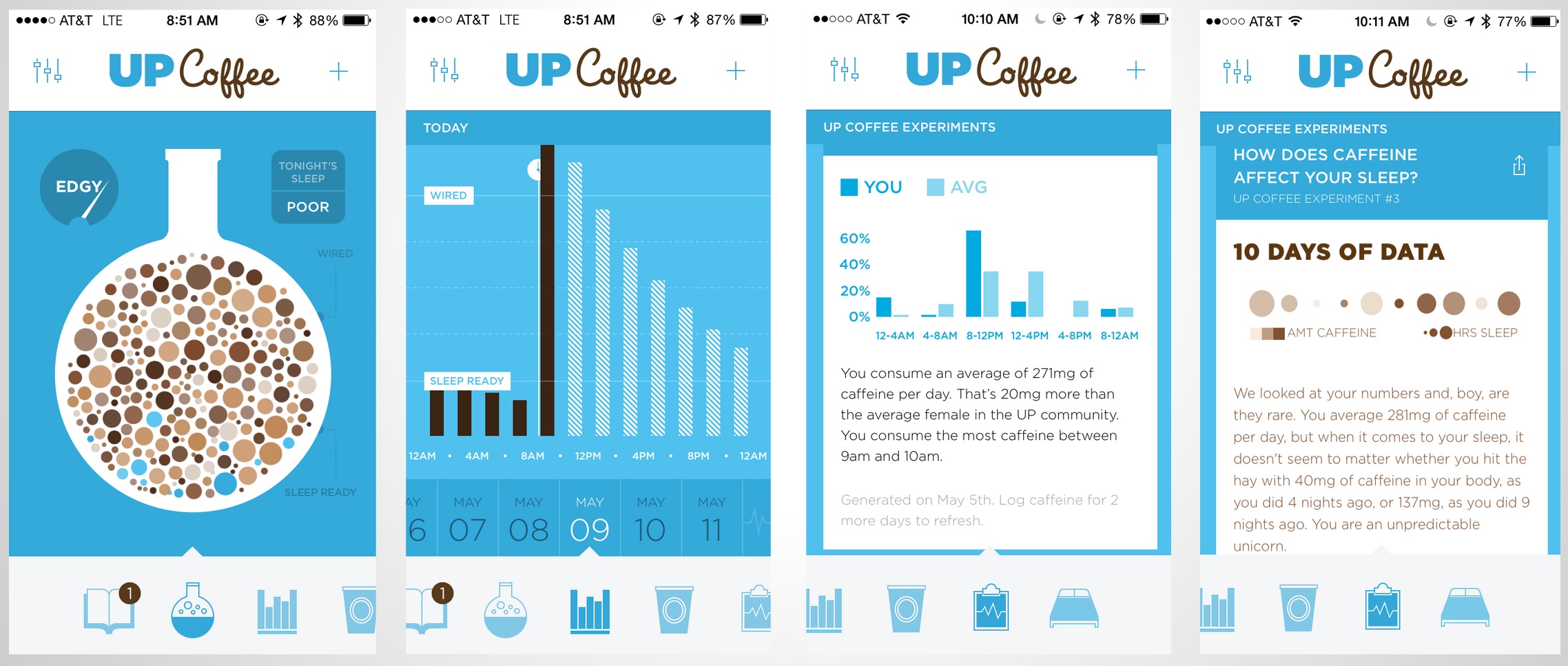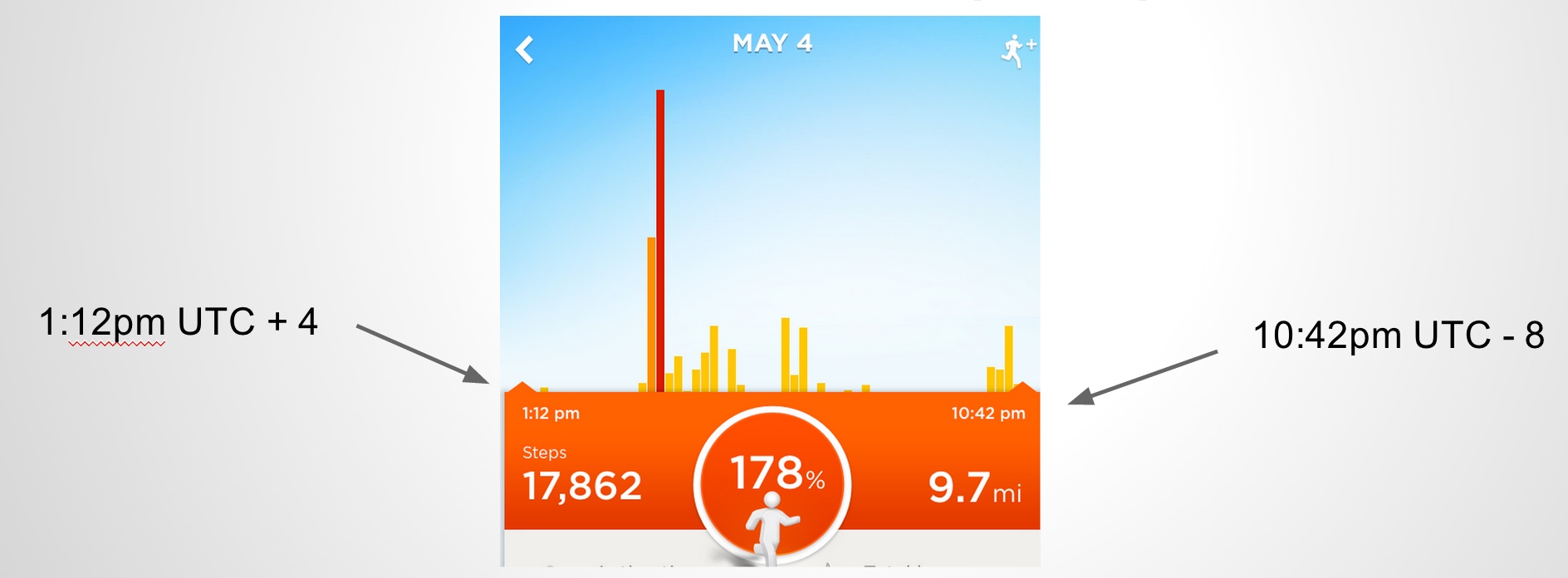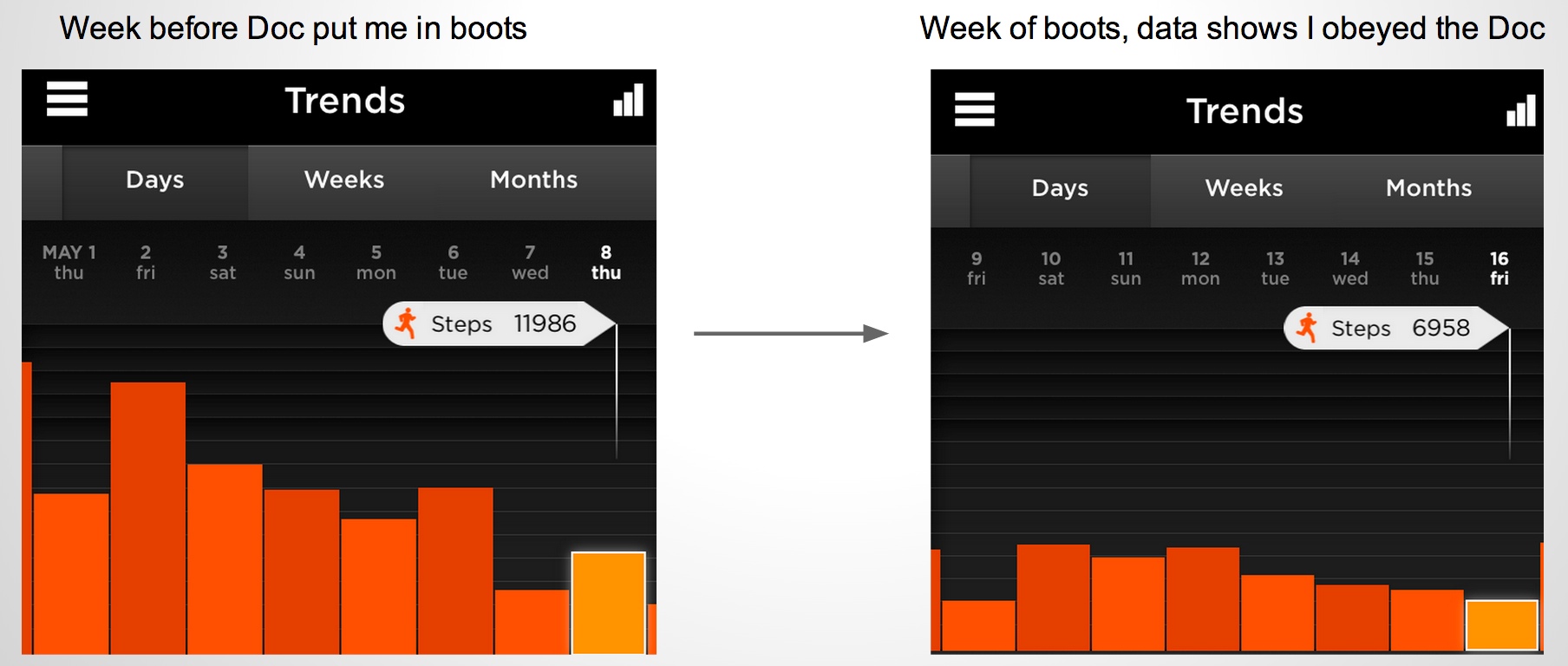I recently gave a talk about one of my passions, the quantification of self, to my team. Given the great feedback, I’m turning that preso into a blog post to share with everyone! I’d like to note that this preso and subsequent blog post was inspired by an awesome presentation that Michele Kiss gave at the Digital Analytics Association SF Chapter Symposium last fall in San Francisco. You can see her preso on her blog.
The market today is full of tools, apps & wearables and the idea of self-quantification is steadily moving towards the mainstream. A lot of my friends have some type of an activity or fitness tracker (though my groups of friends are divided between the Fuelband, Fitbit, and my favorite, the Jawbone UP – each group very passionately believes their tool is the best).
These tools allow us to begin to understand many things about ourselves in a quantified manner and can help us change or modify behaviors for the better.
When I tell friends, family, and acquaintances about why I love my Jawbone UP and how it has impacted my life, the most frequent question or response that I get is ‘how can a fitness tracker change your life?’ Well, I can definitely argue that it has, in fact, changed by life, but for ease and clarity, I’ll instead refer to how a fitness tracker has changed my behavior.
There are 3 main ways that quantifying myself has impacted my behavior:
1. Activity This is the most referenced or thought of category when it comes to trackers, mainly because the idea of counting daily steps has become quite popular in the past few years.
The first time I tracked my steps was when I participated in the ‘Global Corporate Challenge’ (GCC) in 2010. As part of the challenge, each participant was provided with 2 pedometers to track their steps each day, and collectively a team of 7 would try to outdo other teams around the world with their total weekly step count.
I’ve since graduated through a few more trackers (moved from the GCC provided pedometers to a Fitbit and now to the Jawbone UP24), but the concept remains the same: beat 10,000 steps every single day.
By continually watching my step count, and event getting push notification reminders of where I’m at during the day, I regularly exceed this goal. So why has this changed my behavior? Motivation – I don’t want to break the streak. Even on rest days I’m motivated to go for that extra walk to push me over the goal line. I know that if I didn’t have that extra incentive I would not always hit my made up goal of 10K steps a day.
2. Sleep
Sleep tracking is relatively new to me. I tracked my sleep sporadically when I wore the fitibit. While interesting, I didn’t see much of a benefit as all it did was show me how long I slept for. In comparison, I track my sleep every single night with my Jawbone UP24. Why did my behavior change between trackers? Simple – the UP has significantly better data about my sleep patterns. It shows my total amount of sleep, how that compares to my stated goal (7hrs/night), and how much deep (REM) sleep vs light sleep vs awake time I had for the night.
While I’m definitely motivated by the step tracking aspects of fitness trackers, I find myself even more motivated by the sleep tracking. Does it impact my behavior? Definitely. I’ve gotten more sleep per night since wearing my Jawbone, mostly because I feel really guilty/bad if I see less than 6 hours of tracked sleep. I don’t hit my 7hr goal every day (I try to hit it 2x/week), but I do monitor to make sure that I’m getting a decent amount of sleep regularly. And it’s not just about the hours (my fitbit could do that!). I also monitor to make sure I’m not waking up too often and that I’m getting a decent amount of deep sleep.
One pattern that I’ve noticed is that I sleep really poorly on the guest bed at my parents house. Every time I sleep there, I get very little deep sleep and wake up several times per night. Contrasted with sleeping in my own bed, and I’m able to quantify why I’m feeling how I feel (and consequently, why it’s always harder to get up in the morning when staying at my parent’s house). Here are some sleep & activity examples from my Jawbone UP:
3. Consumption
In this case, I’m really only referring to the consumption of caffeine, but many people use their fitness trackers to account for all food & beverage intake.
I use the UP Coffee app which integrates with the Jawbone UP app to show the impact of caffeine on sleep. This has actually ended up being one of the most impactful quantification tools I’ve used because it actually impacted the amount of coffee I drink on a daily basis. Before using this app, I would generally have a large red-eye in the morning (about 300mg of caffeine), and a 12oz iced coffee at lunch time (about 145mg of caffeine). What I noticed, however, when starting to use the app, was that I actually still had a lot of caffeine in my system at noon – I didn’t need that second coffee (mind over matter). So I stopped drinking a lunch time iced coffee. And guess what? I actually don’t feel any different. Here are a few screenshots of the app in action (showing total caffeine consumption, caffeine tapering off throughout the day, and ‘coffee experiments’ data comparing my caffeine intake to my sleep patterns).
Is all of this perfect? No (see the example below – when traveling from Moscow back to California my Jawbone didn’t quite pick up on the fact that I had more than 24 hours in the day). But it’s directional enough to influence behavior.
And it also keeps me accountable. The social news feed feature of the Jawbone actually keeps me more accountable than I might like at times – for example, my friends could see if I was obeying the doctor’s orders recently when I was told to take it easy for a couple of weeks to rest some swollen joints… I couldn’t hide from them!
Data, accountability, and community are the top reasons I continue to invest time and interest in the quantified-self movement. I’m always looking for the next fun, nerdy, data driven thing, so if you hear of something new, let me know!
Human Analytics – The Quantification of Myself
I recently gave a talk about one of my passions, the quantification of self, to my team. Given the great feedback, I’m turning that preso into a blog post to share with everyone! I’d like to note that this preso and subsequent blog post was inspired by an awesome presentation that Michele Kiss gave at the Digital Analytics Association SF Chapter Symposium last fall in San Francisco. You can see her preso on her blog.
The market today is full of tools, apps & wearables and the idea of self-quantification is steadily moving towards the mainstream. A lot of my friends have some type of an activity or fitness tracker (though my groups of friends are divided between the Fuelband, Fitbit, and my favorite, the Jawbone UP – each group very passionately believes their tool is the best).
These tools allow us to begin to understand many things about ourselves in a quantified manner and can help us change or modify behaviors for the better.
When I tell friends, family, and acquaintances about why I love my Jawbone UP and how it has impacted my life, the most frequent question or response that I get is ‘how can a fitness tracker change your life?’ Well, I can definitely argue that it has, in fact, changed by life, but for ease and clarity, I’ll instead refer to how a fitness tracker has changed my behavior.
There are 3 main ways that quantifying myself has impacted my behavior:
1. Activity
This is the most referenced or thought of category when it comes to trackers, mainly because the idea of counting daily steps has become quite popular in the past few years.
The first time I tracked my steps was when I participated in the ‘Global Corporate Challenge’ (GCC) in 2010. As part of the challenge, each participant was provided with 2 pedometers to track their steps each day, and collectively a team of 7 would try to outdo other teams around the world with their total weekly step count.
I’ve since graduated through a few more trackers (moved from the GCC provided pedometers to a Fitbit and now to the Jawbone UP24), but the concept remains the same: beat 10,000 steps every single day.
By continually watching my step count, and event getting push notification reminders of where I’m at during the day, I regularly exceed this goal. So why has this changed my behavior? Motivation – I don’t want to break the streak. Even on rest days I’m motivated to go for that extra walk to push me over the goal line. I know that if I didn’t have that extra incentive I would not always hit my made up goal of 10K steps a day.
2. Sleep
Sleep tracking is relatively new to me. I tracked my sleep sporadically when I wore the fitibit. While interesting, I didn’t see much of a benefit as all it did was show me how long I slept for. In comparison, I track my sleep every single night with my Jawbone UP24. Why did my behavior change between trackers? Simple – the UP has significantly better data about my sleep patterns. It shows my total amount of sleep, how that compares to my stated goal (7hrs/night), and how much deep (REM) sleep vs light sleep vs awake time I had for the night.
While I’m definitely motivated by the step tracking aspects of fitness trackers, I find myself even more motivated by the sleep tracking. Does it impact my behavior? Definitely. I’ve gotten more sleep per night since wearing my Jawbone, mostly because I feel really guilty/bad if I see less than 6 hours of tracked sleep. I don’t hit my 7hr goal every day (I try to hit it 2x/week), but I do monitor to make sure that I’m getting a decent amount of sleep regularly. And it’s not just about the hours (my fitbit could do that!). I also monitor to make sure I’m not waking up too often and that I’m getting a decent amount of deep sleep.
One pattern that I’ve noticed is that I sleep really poorly on the guest bed at my parents house. Every time I sleep there, I get very little deep sleep and wake up several times per night. Contrasted with sleeping in my own bed, and I’m able to quantify why I’m feeling how I feel (and consequently, why it’s always harder to get up in the morning when staying at my parent’s house). Here are some sleep & activity examples from my Jawbone UP:
3. Consumption
In this case, I’m really only referring to the consumption of caffeine, but many people use their fitness trackers to account for all food & beverage intake.
I use the UP Coffee app which integrates with the Jawbone UP app to show the impact of caffeine on sleep. This has actually ended up being one of the most impactful quantification tools I’ve used because it actually impacted the amount of coffee I drink on a daily basis. Before using this app, I would generally have a large red-eye in the morning (about 300mg of caffeine), and a 12oz iced coffee at lunch time (about 145mg of caffeine). What I noticed, however, when starting to use the app, was that I actually still had a lot of caffeine in my system at noon – I didn’t need that second coffee (mind over matter). So I stopped drinking a lunch time iced coffee. And guess what? I actually don’t feel any different. Here are a few screenshots of the app in action (showing total caffeine consumption, caffeine tapering off throughout the day, and ‘coffee experiments’ data comparing my caffeine intake to my sleep patterns).
Is all of this perfect? No (see the example below – when traveling from Moscow back to California my Jawbone didn’t quite pick up on the fact that I had more than 24 hours in the day). But it’s directional enough to influence behavior.
And it also keeps me accountable. The social news feed feature of the Jawbone actually keeps me more accountable than I might like at times – for example, my friends could see if I was obeying the doctor’s orders recently when I was told to take it easy for a couple of weeks to rest some swollen joints… I couldn’t hide from them!
Data, accountability, and community are the top reasons I continue to invest time and interest in the quantified-self movement. I’m always looking for the next fun, nerdy, data driven thing, so if you hear of something new, let me know!
Krista
You might also like
Step by Step: Setting up a GA4 Property in Google Analytics
New App + Web Properties in Google Analytics
Goodbye, Google
Three Google Analytics Features You Should Be Using Today
Next ArticleYour Optimization Program's First Hire